A 10-step home office energy audit can greatly reduce your utility bills and carbon footprint. Start by evaluating your current energy usage and assessing lighting efficiency. Check your HVAC system's performance and inspect windows and insulation for leaks. Analyze your computer and electronics setup, focusing on power-hungry devices and standby energy consumption. Consider smart device integration and renewable energy options like solar panels. Implement energy-saving habits, such as turning off unused devices and utilizing natural light. Don't forget to calculate potential cost savings to track your progress. By following these steps, you'll uncover numerous ways to optimize your home office's energy efficiency.
Assess Current Energy Usage
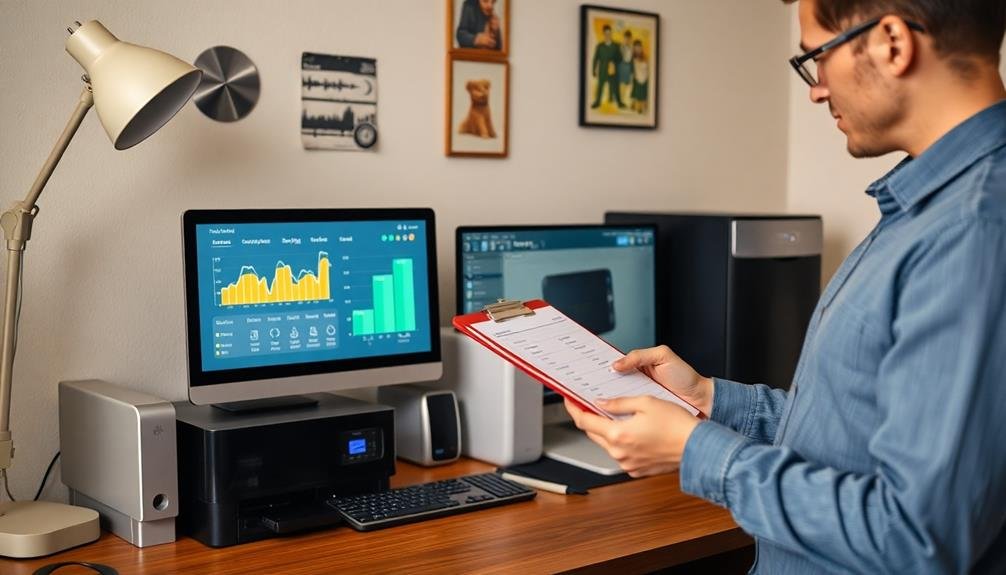
The first step in conducting a home office energy audit is to assess your current energy usage. Start by gathering your energy bills from the past year to identify patterns and peak usage periods. Review these bills to calculate your average monthly energy consumption and costs.
Next, make a detailed inventory of all electronic devices and appliances in your home office. List each item's wattage and estimate its daily usage hours. This will help you pinpoint which devices are consuming the most energy.
Use a power meter to measure the actual energy consumption of your devices, especially those that remain plugged in when not in use. This will reveal any "phantom" or standby power draw.
Consider the lighting in your office space. Count the number of light fixtures and bulbs, noting their wattage and daily usage. Don't forget to account for natural light sources and their potential impact on your energy needs.
Lastly, evaluate your heating and cooling systems. Check the age and efficiency of your HVAC equipment, and note how often you adjust the thermostat for your home office area.
This thorough assessment will provide a clear picture of your current energy consumption habits.
Evaluate Lighting Efficiency
Start your lighting evaluation by taking stock of the bulbs you're currently using in your home office.
Next, consider how you're utilizing natural light and whether you can maximize its benefits throughout the day.
Assess Current Bulb Types
When evaluating your home office's lighting efficiency, examining the current bulb types is an essential step. Start by identifying the different types of bulbs you're using. Common varieties include incandescent, compact fluorescent lamps (CFLs), halogen, and light-emitting diodes (LEDs).
Incandescent bulbs are traditional and inexpensive but consume more energy and have shorter lifespans. CFLs use less energy and last longer but contain small amounts of mercury. Halogen bulbs are more efficient than incandescents but still lag behind newer technologies. LEDs are the most energy-efficient option, lasting up to 25 times longer than incandescent bulbs and using 75% less energy.
Check each bulb's wattage and compare it to the room's lighting needs. You might be using higher wattage bulbs than necessary, wasting energy.
Also, note the color temperature of each bulb. Warmer tones (2700-3000K) are suitable for relaxation, while cooler tones (4000-6500K) enhance productivity.
Consider Natural Light Usage
Once you've assessed your current bulb types, it's time to turn your attention to natural light usage. Maximizing natural light can considerably reduce your reliance on artificial lighting, leading to lower energy consumption and costs.
Start by evaluating your home office's window placement and size. Are there any obstructions blocking sunlight from entering the room?
Consider rearranging your workspace to take advantage of available natural light. Position your desk near windows, but be mindful of potential glare on your computer screen. You might need to install adjustable blinds or shades to control light intensity throughout the day.
Reflective surfaces, such as light-colored walls or strategically placed mirrors, can help distribute natural light more effectively throughout the room.
If your home office lacks sufficient windows, explore the possibility of adding skylights or solar tubes. These can dramatically increase natural light without sacrificing privacy or wall space.
Additionally, keep your windows clean and unobstructed to maximize light transmission. Trim any outdoor vegetation that may be blocking sunlight from entering your workspace.
Install Smart Lighting Controls
Smart lighting controls are the next step in optimizing your home office's energy efficiency. These systems allow you to automate and fine-tune your lighting usage, reducing energy waste and lowering your electricity bills.
Start by installing motion sensors in areas where you don't need constant illumination. These will automatically turn lights on when you enter the room and off when you leave, ensuring you never forget to switch them off.
Dimmer switches are another valuable addition, letting you adjust light levels based on the time of day or your specific tasks. For even more control, consider smart bulbs or fixtures that can be programmed and controlled via smartphone apps or voice assistants. These allow you to create custom lighting schedules, adjust color temperature, and even control lights remotely.
Don't forget about task lighting. Use LED desk lamps with adjustable brightness to focus light where you need it most, reducing the need for overhead lighting.
Check HVAC System Performance
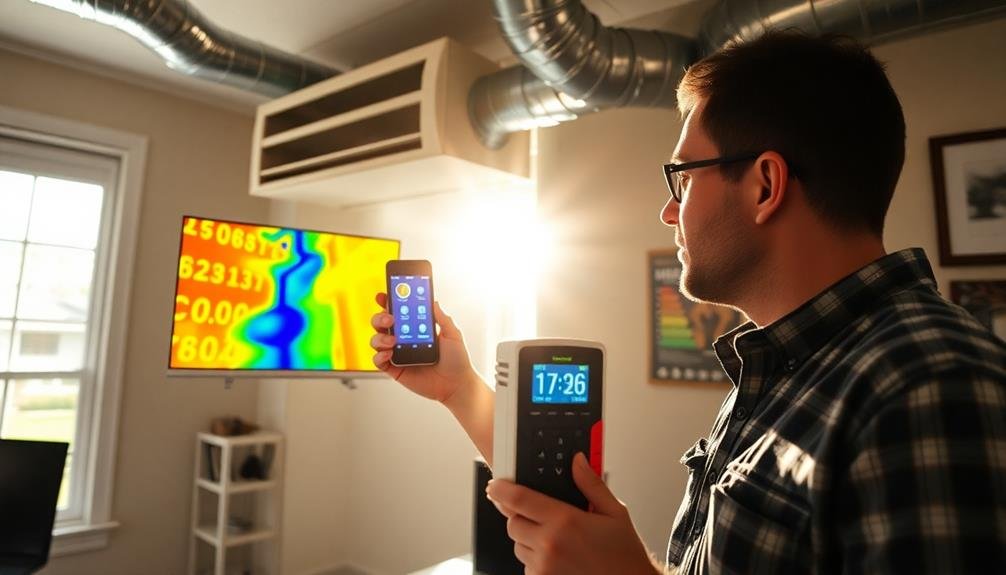
For ideal energy efficiency, your HVAC system's performance should be thoroughly assessed. Start by checking your air filters and replacing them if they're dirty. Clogged filters force your system to work harder, increasing energy consumption.
Next, inspect your ductwork for leaks or damage, as these can greatly reduce efficiency. Seal any gaps with mastic sealant or metal tape to prevent air loss.
Don't forget to examine your outdoor unit. Clear away debris and vegetation to guarantee proper airflow. If you're comfortable with DIY tasks, clean the condenser coils to improve heat transfer.
However, for a detailed evaluation, consider hiring a professional HVAC technician. They can:
- Measure airflow and adjust fan speed if necessary
- Check refrigerant levels and address any leaks
- Calibrate your thermostat for accurate temperature control
- Lubricate moving parts to reduce friction and energy waste
Regular maintenance of your HVAC system not only improves energy efficiency but also extends its lifespan. By addressing issues promptly, you'll avoid costly repairs and replacements down the line.
Inspect Windows and Insulation
Focusing on your home's thermal envelope, inspecting windows and insulation is essential for maximizing energy efficiency.
Start by examining your windows for drafts or leaks. Run your hand along the edges to feel for air movement, and look for gaps or cracks in the caulking or weatherstripping. If you find issues, seal them promptly to prevent heat loss.
Next, check your insulation. In the attic, verify you have adequate coverage and depth. The recommended R-value varies by region, so consult local guidelines.
Don't forget to inspect walls and floors for proper insulation as well. If you're unsure about your insulation's condition, consider hiring a professional for a thorough assessment.
For windows, consider upgrading to double-pane or triple-pane models if you have older, single-pane versions. These modern alternatives greatly reduce heat transfer.
Additionally, install thermal curtains or cellular shades to further improve insulation.
In crawl spaces and basements, inspect for moisture issues that could compromise insulation effectiveness. Address any dampness or mold problems promptly.
Analyze Computer and Electronics Setup
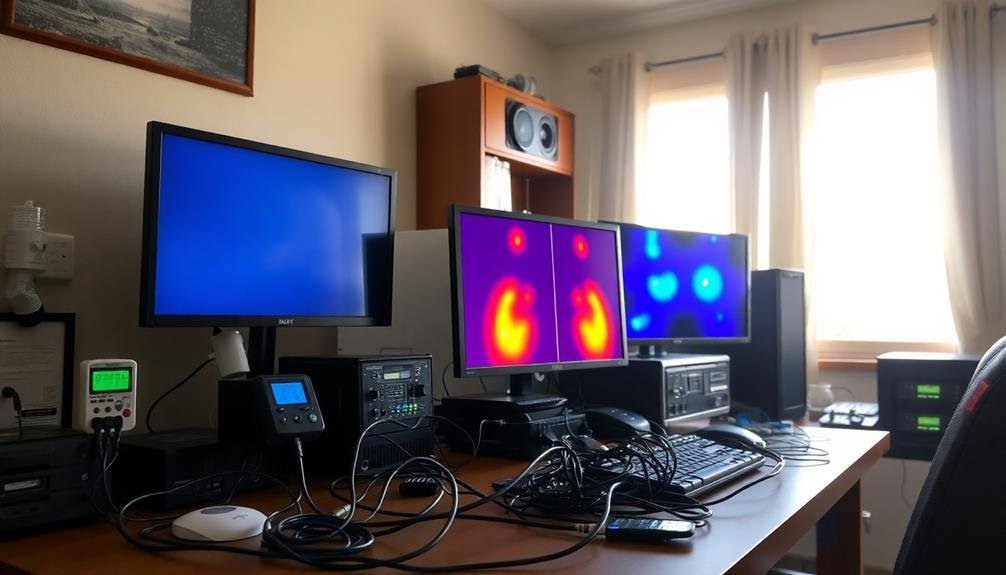
Begin your home office energy analysis by identifying power-hungry devices like desktop computers, printers, and multiple monitors.
You'll want to enable energy-saving settings on all your electronics, including sleep modes and automatic shutdowns when not in use.
Don't forget to evaluate standby power usage, as many devices continue to draw electricity even when turned off.
Consider using smart power strips to completely cut power to idle equipment.
Assess Power-Hungry Devices
In your home office, computers and electronic devices are often the biggest energy consumers. It's vital to identify and address these power-hungry devices to reduce your energy consumption and lower your electricity bills.
Start by examining your computer setup, including monitors, speakers, and peripherals. Don't forget to check other electronic equipment like printers, scanners, and routers.
To effectively assess your power-hungry devices:
- Use a wattage meter to measure the energy consumption of each device.
- Check for "phantom" or standby power usage when devices are turned off.
- Identify older, less efficient equipment that may need replacement.
- Look for energy-saving features on your devices and confirm they're enabled.
Pay special attention to equipment that generates heat, as it's likely consuming more energy.
Consider replacing desktop computers with laptops, which typically use less power. Implement smart power strips to eliminate standby power consumption and make it easier to turn off multiple devices at once.
Implement Energy-Saving Settings
After identifying your power-hungry devices, it's time to optimize their energy consumption through smart settings.
Start with your computer, the centerpiece of your home office. Enable sleep mode to automatically power down after periods of inactivity. Adjust your display settings to reduce brightness and set a shorter screen timeout. For laptops, customize power plans to prioritize battery life over performance when unplugged.
Don't overlook peripherals. Configure printers and scanners to enter sleep mode when idle. If you use a gaming console for work-related tasks, enable its power-saving features.
For your smartphone and tablet, turn on low-power mode and disable background app refresh.
Smart power strips can help manage multiple devices. Use them to cut power to equipment when your computer shuts down. Consider installing a programmable thermostat to optimize heating and cooling based on your work schedule.
Review your software usage. Close unnecessary browser tabs and applications to reduce processing power. Use cloud-based services to offload demanding tasks from your local machine.
Evaluate Standby Power Usage
Many electronic devices in your home office continue to draw power even when they're not in use, a phenomenon known as standby power or vampire power. This silent energy drain can markedly impact your electricity bill and carbon footprint.
To evaluate and reduce standby power usage, you'll need to assess your computer and electronics setup carefully.
Start by identifying all devices in your home office that remain plugged in when not in active use. This may include computers, monitors, printers, routers, and charging stations. Use a power meter to measure the standby power consumption of each device.
Once you've gathered this information, consider implementing these strategies to minimize standby power usage:
- Unplug devices when not in use or use power strips to cut off power completely
- Enable power-saving modes on all electronics, including sleep and hibernation settings
- Invest in ENERGY STAR certified equipment, which typically has lower standby power consumption
- Use smart power strips that automatically cut power to peripheral devices when the main device is turned off
Review Power Strip Configuration
Efficiency in your home office extends to the often-overlooked power strip configuration. Your power strips play a vital role in managing energy consumption and protecting your devices.
Start by evaluating the number and placement of power strips in your workspace. Make sure you have enough outlets to accommodate all your devices without overloading any single strip.
Next, examine the types of power strips you're using. Opt for surge-protected strips to safeguard your electronics from power fluctuations. Consider investing in smart power strips that automatically cut power to devices in standby mode, eliminating phantom energy drain.
Organize your devices strategically on the power strips. Group items that you frequently use together on the same strip, making it easier to power them on and off simultaneously. Place rarely used devices on a separate strip that you can easily switch off when not in use.
Label your power strips and cords for quick identification. This practice helps you quickly locate and manage specific devices.
Examine Printer and Scanner Usage

Analyze your printing habits to determine if you're using your printer more than necessary.
Consider implementing a digital filing system to reduce paper consumption and energy use.
Adjust your scanner's settings to optimize energy efficiency, ensuring it's not left in standby mode for extended periods.
Assess Printing Frequency
Printers and scanners, often overlooked energy consumers, can greatly impact your home office's power usage. To assess your printing frequency, start by tracking your print jobs over a week or month. This will give you a clear picture of your actual printing needs and habits.
Consider these steps to optimize your printing practices:
- Go digital: Whenever possible, opt for digital documents instead of printing. Use PDF readers, digital signatures, and cloud storage to reduce paper consumption.
- Print double-sided: When you must print, use both sides of the paper to cut your paper usage in half.
- Use draft mode: For non-essential prints, switch to draft or economy mode to save ink and energy.
- Batch your print jobs: Instead of printing sporadically throughout the day, group your print tasks to minimize the number of times you power up the printer.
Optimize Scanner Settings
Scrutinizing your scanner settings can lead to significant energy savings in your home office. Start by examining your scanner's power management options. Most modern scanners have energy-saving modes that automatically power down the device when it's not in use. Activate these features to minimize standby power consumption.
Consider adjusting the scanner's resolution settings. Higher resolutions consume more energy and take longer to complete scans. For everyday documents, a lower resolution (e.g., 300 dpi) is often sufficient and uses less power. Reserve higher resolutions for when you need detailed scans of photos or complex graphics.
Opt for preview scans before final scans to guarantee proper alignment and cropping. This prevents unnecessary rescans and saves energy. If your scanner has a warm-up time, group your scanning tasks together to avoid multiple warm-up cycles.
Additionally, clean your scanner's glass regularly to maintain efficiency and reduce the need for repeated scans due to dust or smudges.
When possible, use your scanner's OCR (Optical Character Recognition) feature to create editable digital documents instead of printing scanned files. This approach reduces both energy consumption and paper waste in your home office.
Assess Smart Device Integration
Smart devices can considerably impact your home office's energy consumption. When evaluating your smart device integration, you'll want to assess how these technologies are affecting your overall energy usage.
Consider the potential savings and efficiency gains that smart devices can offer, but also be mindful of their own power requirements.
To effectively evaluate your smart device integration, focus on these key areas:
- Smart thermostats: Analyze how well your programmable thermostat is optimizing heating and cooling for your home office hours.
- Smart power strips: Evaluate if you're using these to automatically cut power to devices when they're not in use.
- Smart lighting: Check if your smart bulbs or switches are effectively managing illumination based on occupancy and natural light levels.
- Energy monitoring systems: Determine if you've implemented tools to track and analyze your office's energy consumption in real-time.
Look for opportunities to integrate these devices more effectively, such as creating automation routines that power down non-essential equipment outside of working hours.
Consider upgrading to more energy-efficient smart devices if your current ones are outdated.
Consider Renewable Energy Options
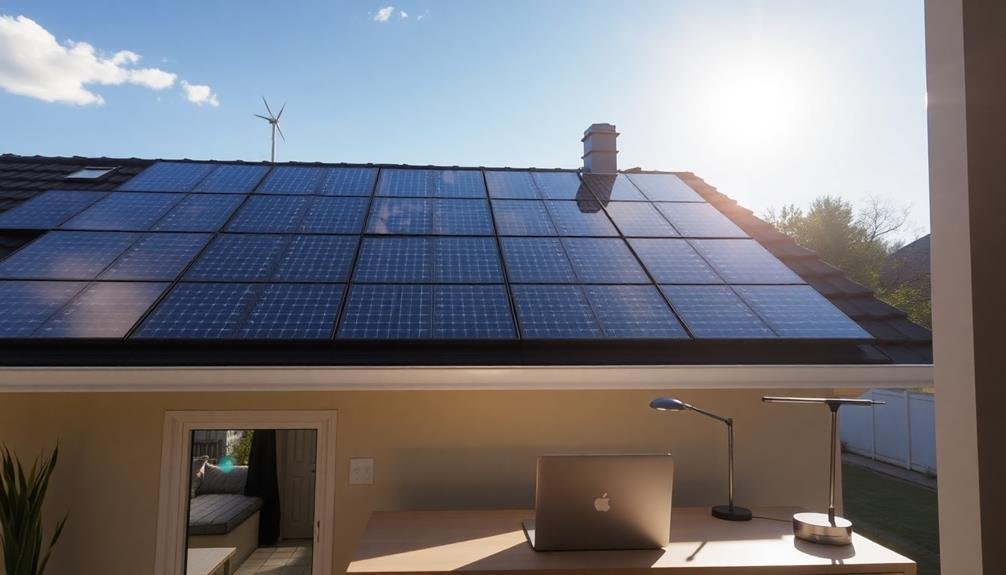
Incorporating renewable energy into your home office can greatly reduce your carbon footprint and long-term energy costs. Start by evaluating solar panel options for your home. Even a small array can power your office equipment and contribute excess energy to the grid.
If you've got limited roof space, consider portable solar panels that you can set up on a balcony or in your yard.
For those in windy areas, a small wind turbine might be viable. While less common for residential use, it can be an effective complement to solar power.
Geothermal heat pumps are another option, especially if you're looking to heat and cool your entire home efficiently.
Don't overlook micro-hydropower if you have a stream on your property. It's a consistent energy source that works day and night.
For a more accessible option, explore solar water heaters to reduce your energy consumption for hot water needs.
Lastly, consider investing in a home battery system to store excess energy from your renewable sources. This guarantees you'll have power even when the sun isn't shining or the wind isn't blowing, maximizing your renewable energy usage.
Implement Energy-Saving Habits
Beyond investing in energy-efficient equipment and renewable sources, adopting energy-saving habits can greatly reduce your home office's power consumption.
Start by turning off all devices and lights when you're not using them. This simple act can save a significant amount of energy over time. Make it a habit to unplug chargers and electronics that aren't in use, as they continue to draw power even when turned off.
Enhance your computer's power settings to maximize energy savings. Set it to sleep mode after a short period of inactivity and adjust the screen brightness to a comfortable, yet energy-efficient level. When possible, use natural light instead of artificial lighting to illuminate your workspace.
Here are four additional energy-saving habits to implement:
- Use a smart power strip to easily cut power to multiple devices
- Dress appropriately for the season to reduce heating and cooling needs
- Regularly clean and maintain your HVAC system for peak efficiency
- Use task lighting instead of overhead lights when working late
Calculate Potential Cost Savings

To truly understand the impact of your energy-saving efforts, you'll need to calculate the potential cost savings. Start by gathering your past energy bills and noting your average monthly consumption. Then, estimate the reduction in energy use for each implemented change. For example, switching to LED bulbs can cut lighting costs by up to 75%.
Next, research the current electricity rates in your area. Multiply your estimated energy savings by the rate to determine your monthly cost reduction.
Don't forget to factor in any upfront costs for new equipment or upgrades. Calculate the payback period by dividing these costs by your monthly savings.
Consider using online energy calculators or smartphone apps to simplify this process. Many utility companies offer free tools to help you estimate savings based on specific changes.
Remember to account for seasonal variations in energy use and adjust your calculations accordingly.
Frequently Asked Questions
How Often Should I Conduct a Home Office Energy Audit?
You should conduct a home office energy audit annually. It's best to do it at the start of each year or when seasons change. Regular audits help you identify new savings opportunities and maintain energy efficiency in your workspace.
Can I Hire a Professional for a More Thorough Energy Audit?
Yes, you can hire a professional energy auditor for a more extensive assessment. They'll use specialized equipment to identify energy inefficiencies you might miss. This thorough audit can provide detailed recommendations for improving your home office's energy efficiency.
Are There Government Incentives for Implementing Energy-Saving Measures in Home Offices?
Yes, you'll find various government incentives for energy-saving measures in home offices. Check your local and federal programs for tax credits, rebates, and grants. They often cover upgrades like energy-efficient appliances, insulation, and solar panels.
What's the Average ROI for Energy-Efficient Upgrades in a Home Office?
You'll typically see a 10-30% ROI on energy-efficient upgrades for your home office. It varies based on the specific improvements you make, but you can often recoup your investment within 3-5 years through lower utility bills.
How Do Seasonal Changes Affect Home Office Energy Consumption Patterns?
You'll notice your home office energy use fluctuates with the seasons. In summer, you're likely using more cooling, while winter demands more heating. Lighting needs change too, as daylight hours shift throughout the year.
In Summary
You've now completed your home office energy audit. By following these steps, you'll have identified key areas for improvement and energy-saving opportunities. Don't stop here—take action on your findings. Implement the changes you've discovered, from upgrading lighting to optimizing your HVAC system. Remember, small adjustments can lead to significant savings over time. Keep monitoring your energy usage and stay open to new efficiency technologies. Your wallet and the environment will thank you.

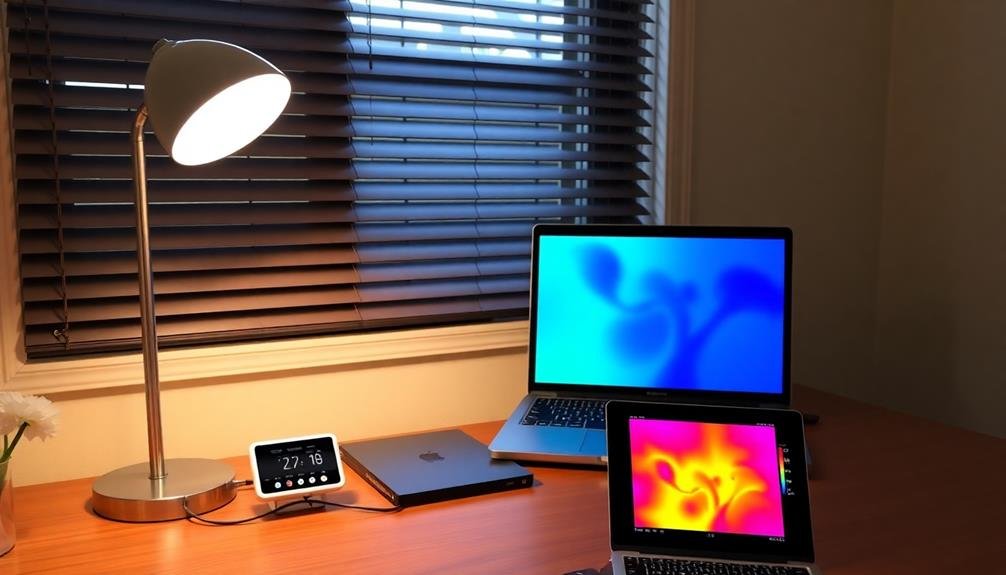
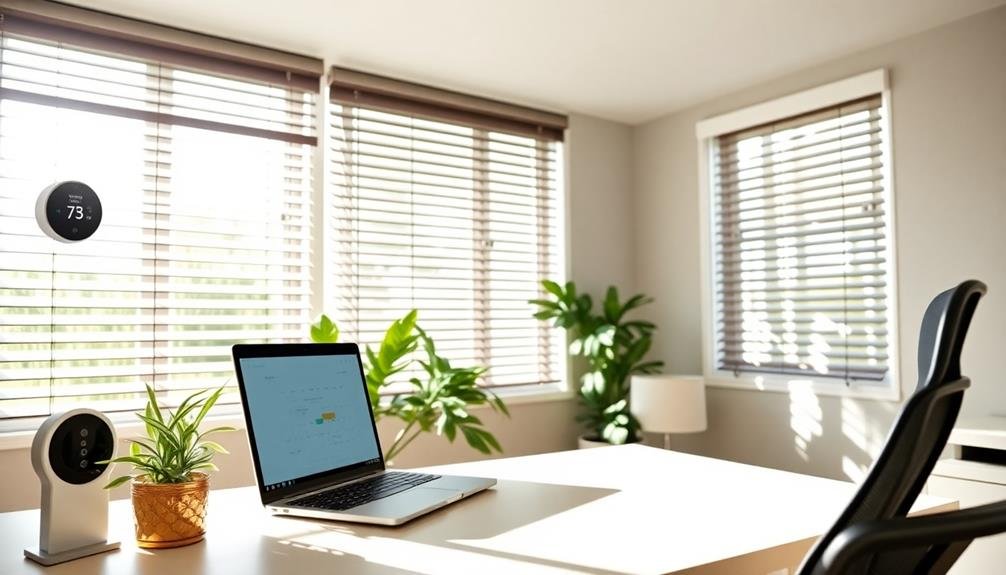
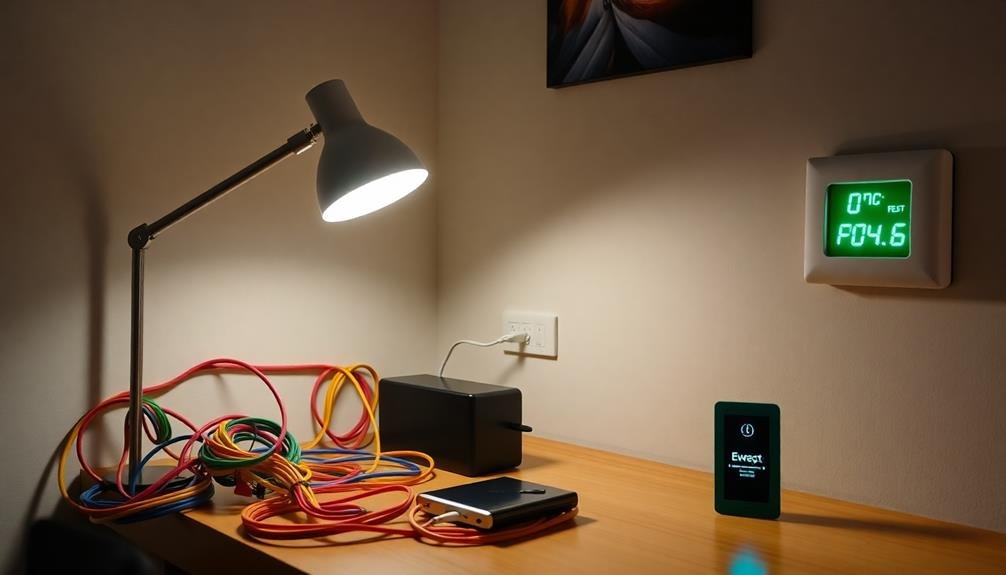
Leave a Reply